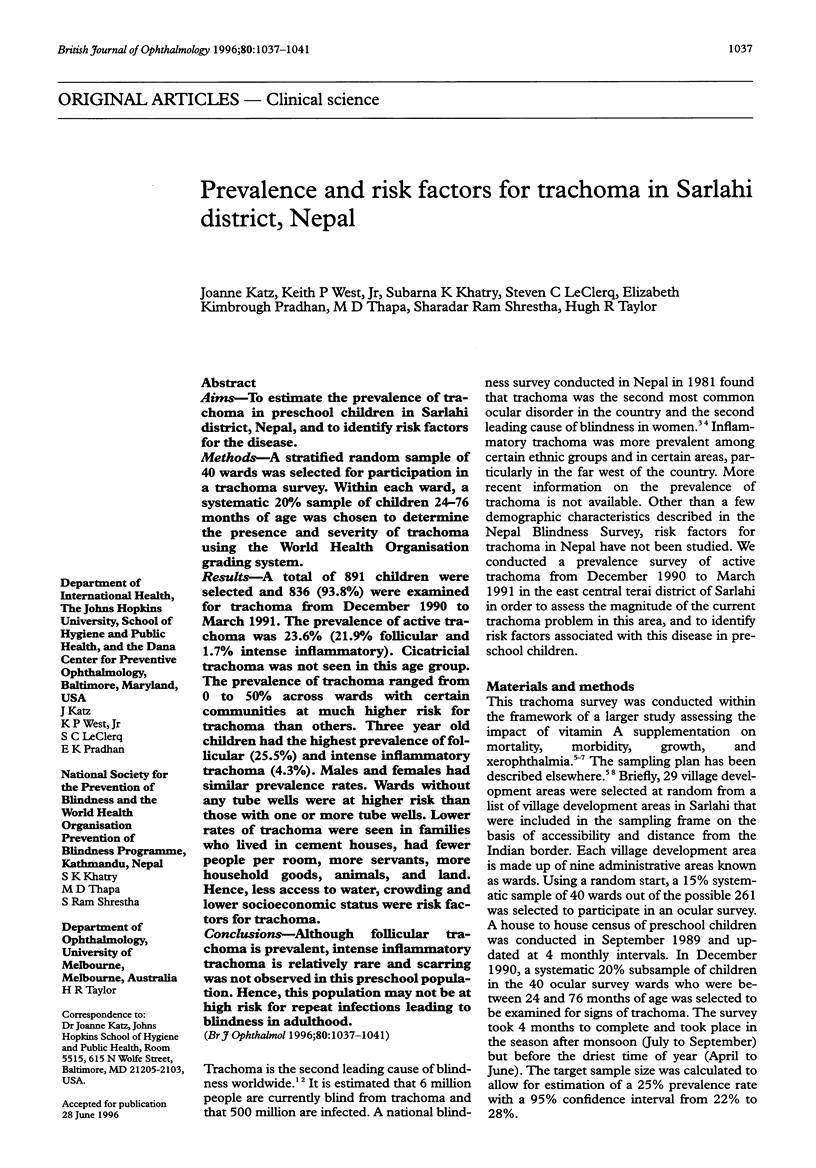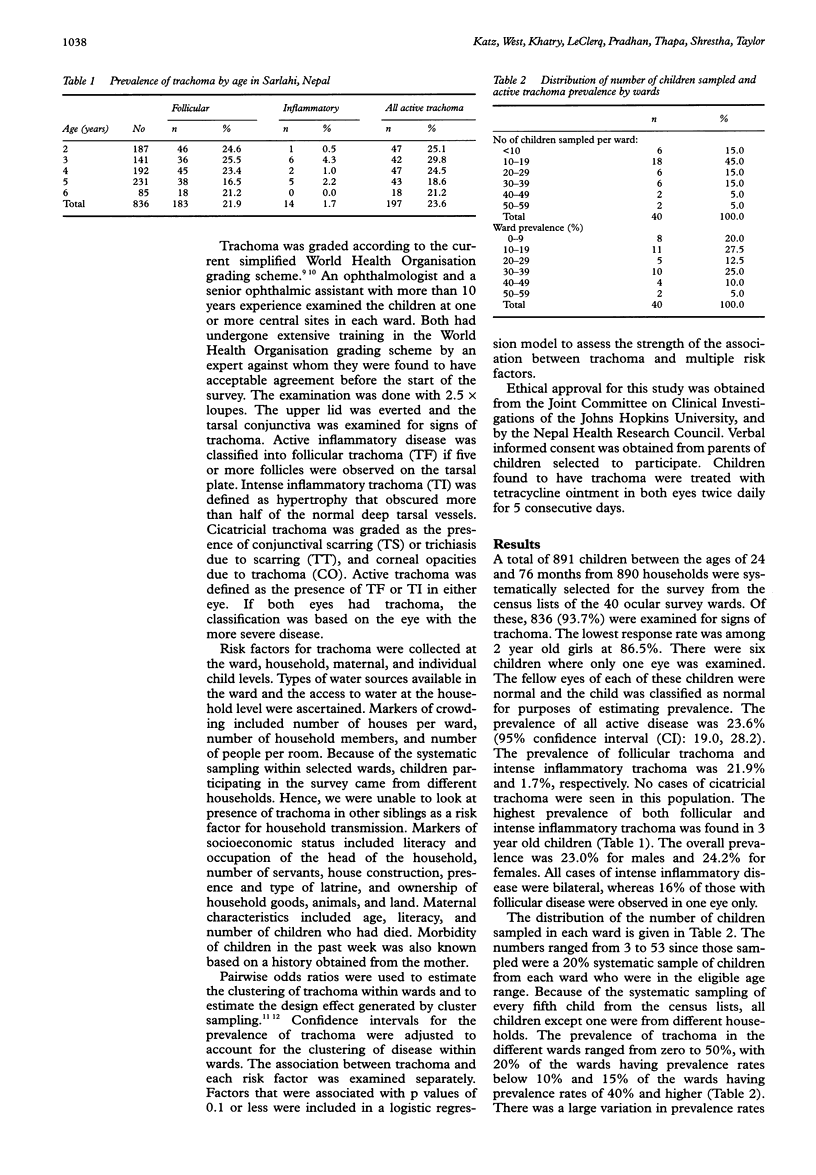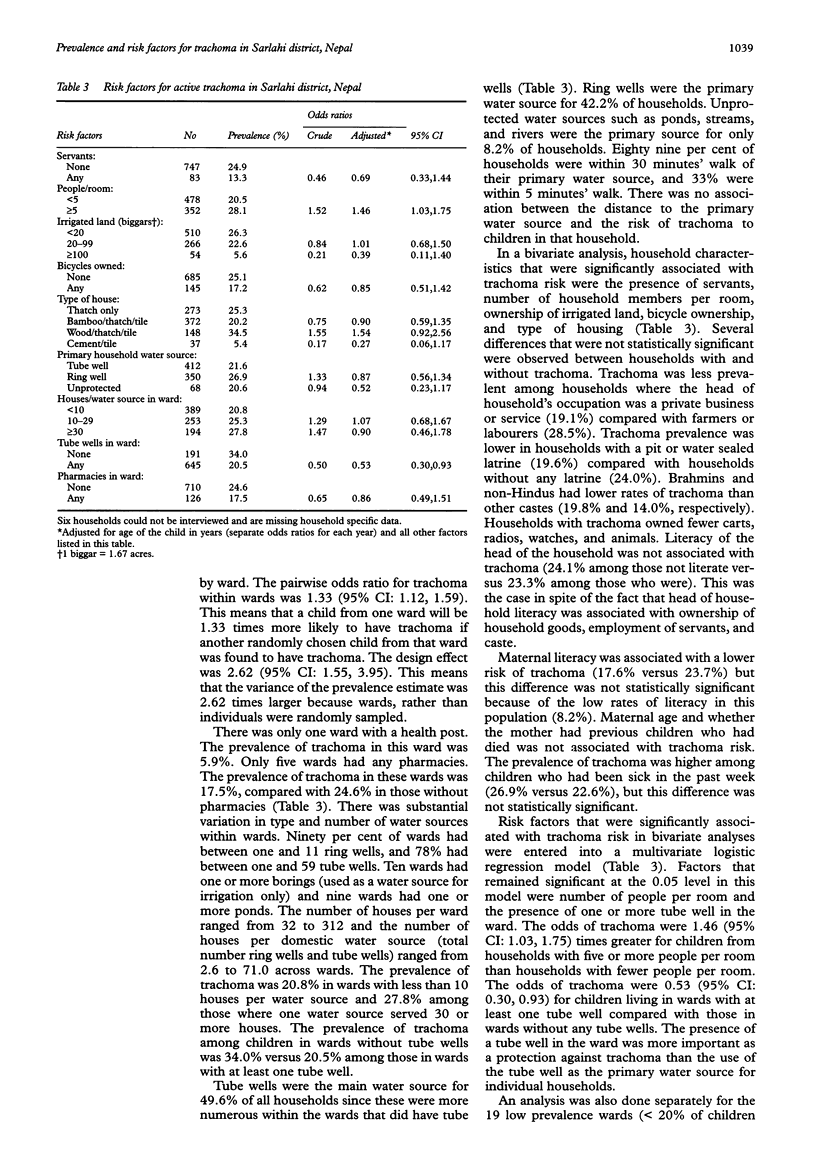Abstract
AIMS: To estimate the prevalence of trachoma in preschool children in Sarlahi district, Nepal, and to identify risk factors for the disease. METHODS: A stratified random sample of 40 wards was selected for participation in a trachoma survey. Within each ward, a systematic 20% sample of children 24-76 months of age was chosen to determine the presence and severity of trachoma using the World Health Organisation grading system. RESULTS: A total of 891 children were selected and 836 (93.8%) were examined for trachoma from December 1990 to March 1991. The prevalence of active trachoma was 23.6% (21.9% follicular and 1.7% intense inflammatory). Cicatricial trachoma was not seen in this age group. The prevalence of trachoma ranged from 0 to 50% across wards with certain communities at much higher risk for trachoma than others. Three year old children had the highest prevalence of follicular (25.5%) and intense inflammatory trachoma (4.3%). Males and females had similar prevalence rates. Wards without any tube wells were at higher risk than those with one or more tube wells. Lower rates of trachoma were seen in families who lived in cement houses, had fewer people per room, more servants, more household goods, animals, and land. Hence, less access to water, crowding and lower socioeconomic status were risk factors for trachoma. CONCLUSIONS: Although follicular trachoma is prevalent, intense inflammatory trachoma is relatively rare and scarring was not observed in this preschool population. Hence, this population may not be at high risk for repeat infections leading to blindness in adulthood.
Full text
PDF




Selected References
These references are in PubMed. This may not be the complete list of references from this article.
- Assaad F. A., Maxwell-Lyons F., Sundaresan T. Use of local variations in trachoma endemicity in depicting interplay between socio-economic conditions and disease. Bull World Health Organ. 1969;41(2):181–194. [PMC free article] [PubMed] [Google Scholar]
- Bailey R., Downes B., Downes R., Mabey D. Trachoma and water use; a case control study in a Gambian village. Trans R Soc Trop Med Hyg. 1991 Nov-Dec;85(6):824–828. doi: 10.1016/0035-9203(91)90470-j. [DOI] [PubMed] [Google Scholar]
- Brilliant L. B., Pokhrel R. P., Grasset N. C., Lepkowski J. M., Kolstad A., Hawks W., Pararajasegaram R., Brilliant G. E., Gilbert S., Shrestha S. R. Epidemiology of blindness in Nepal. Bull World Health Organ. 1985;63(2):375–386. [PMC free article] [PubMed] [Google Scholar]
- Courtright P., Sheppard J., Lane S., Sadek A., Schachter J., Dawson C. R. Latrine ownership as a protective factor in inflammatory trachoma in Egypt. Br J Ophthalmol. 1991 Jun;75(6):322–325. doi: 10.1136/bjo.75.6.322. [DOI] [PMC free article] [PubMed] [Google Scholar]
- Courtright P., Sheppard J., Schachter J., Said M. E., Dawson C. R. Trachoma and blindness in the Nile Delta: current patterns and projections for the future in the rural Egyptian population. Br J Ophthalmol. 1989 Jul;73(7):536–540. doi: 10.1136/bjo.73.7.536. [DOI] [PMC free article] [PubMed] [Google Scholar]
- De Sole G. Impact of cattle on the prevalence and severity of trachoma. Br J Ophthalmol. 1987 Nov;71(11):873–876. doi: 10.1136/bjo.71.11.873. [DOI] [PMC free article] [PubMed] [Google Scholar]
- Katz J., West K. P., Jr, Khatry S. K., Thapa M. D., LeClerq S. C., Pradhan E. K., Pokhrel R. P., Sommer A. Impact of vitamin A supplementation on prevalence and incidence of xerophthalmia in Nepal. Invest Ophthalmol Vis Sci. 1995 Dec;36(13):2577–2583. [PubMed] [Google Scholar]
- Katz J., Zeger S. L. Estimation of design effects in cluster surveys. Ann Epidemiol. 1994 Jul;4(4):295–301. doi: 10.1016/1047-2797(94)90085-x. [DOI] [PubMed] [Google Scholar]
- Marx R. Social factors and trachoma: a review of the literature. Soc Sci Med. 1989;29(1):23–34. doi: 10.1016/0277-9536(89)90124-x. [DOI] [PubMed] [Google Scholar]
- McCauley A. P., Lynch M., Pounds M. B., West S. Changing water-use patterns in a water-poor area: lessons for a trachoma intervention project. Soc Sci Med. 1990;31(11):1233–1238. doi: 10.1016/0277-9536(90)90129-g. [DOI] [PubMed] [Google Scholar]
- Pradhan E. K., Katz J., LeClerq S. C., West K. P., Jr Data management for large community trials in Nepal. Control Clin Trials. 1994 Jun;15(3):220–234. doi: 10.1016/0197-2456(94)90059-0. [DOI] [PubMed] [Google Scholar]
- Prost A., Négrel A. D. Water, trachoma and conjunctivitis. Bull World Health Organ. 1989;67(1):9–18. [PMC free article] [PubMed] [Google Scholar]
- Sahlu T., Larson C. The prevalence and environmental risk factors for moderate and severe trachoma in southern Ethiopia. J Trop Med Hyg. 1992 Feb;95(1):36–41. [PubMed] [Google Scholar]
- Schwab L., Whitfield R., Jr, Ross-Degnan D., Steinkuller P., Swartwood J. The epidemiology of trachoma in rural Kenya. Variation in prevalence with lifestyle and environment. Study Survey Group. Ophthalmology. 1995 Mar;102(3):475–482. doi: 10.1016/s0161-6420(95)30997-9. [DOI] [PubMed] [Google Scholar]
- Sharma J. L., Lal S., Chauhan B. S., Singh M., Singh I. Epidemiological survey of prevalence of trachoma among the school children in Haryana State. Indian J Public Health. 1975 Apr-Jun;19(2):63–68. [PubMed] [Google Scholar]
- Srivastava B. C., Chandra R., Srivastava V. K., Saxena S. C., Nandan D., Gupta R. P. Prevalence of trachoma in school children of a rural community. Indian Pediatr. 1981 Apr;18(4):233–236. [PubMed] [Google Scholar]
- Stocks N. P., Newland H., Hiller J. The epidemiology of blindness and trachoma in the Anangu Pitjantjatjara of South Australia. Med J Aust. 1994 Jun 20;160(12):751–756. doi: 10.5694/j.1326-5377.1994.tb125942.x. [DOI] [PubMed] [Google Scholar]
- Taylor H. R., Velasco F. M., Sommer A. The ecology of trachoma: an epidemiological study in southern Mexico. Bull World Health Organ. 1985;63(3):559–567. [PMC free article] [PubMed] [Google Scholar]
- Taylor H. R., West S. K., Katala S., Foster A. Trachoma: evaluation of a new grading scheme in the United Republic of Tanzania. Bull World Health Organ. 1987;65(4):485–488. [PMC free article] [PubMed] [Google Scholar]
- Taylor H. R., West S. K., Mmbaga B. B., Katala S. J., Turner V., Lynch M., Muñoz B., Rapoza P. A. Hygiene factors and increased risk of trachoma in central Tanzania. Arch Ophthalmol. 1989 Dec;107(12):1821–1825. doi: 10.1001/archopht.1989.01070020903037. [DOI] [PubMed] [Google Scholar]
- Thylefors B., Dawson C. R., Jones B. R., West S. K., Taylor H. R. A simple system for the assessment of trachoma and its complications. Bull World Health Organ. 1987;65(4):477–483. [PMC free article] [PubMed] [Google Scholar]
- Thylefors B., Négrel A. D., Pararajasegaram R. Epidemiologic aspects of global blindness prevention. Curr Opin Ophthalmol. 1992 Dec;3(6):824–834. doi: 10.1097/00055735-199212000-00016. [DOI] [PubMed] [Google Scholar]
- Tielsch J. M., West K. P., Jr, Katz J., Keyvan-Larijani E., Tizazu T., Schwab L., Johnson G. J., Chirambo M. C., Taylor H. R. The epidemiology of trachoma in southern Malawi. Am J Trop Med Hyg. 1988 Mar;38(2):393–399. doi: 10.4269/ajtmh.1988.38.393. [DOI] [PubMed] [Google Scholar]
- Werner G. T., Sareen D. K. Trachoma in Punjab: a study of the prevalence and of mass treatment. Trop Geogr Med. 1977 Jun;29(2):135–140. [PubMed] [Google Scholar]
- West K. P., Jr, Katz J., Shrestha S. R., LeClerq S. C., Khatry S. K., Pradhan E. K., Adhikari R., Wu L. S., Pokhrel R. P., Sommer A. Mortality of infants < 6 mo of age supplemented with vitamin A: a randomized, double-masked trial in Nepal. Am J Clin Nutr. 1995 Jul;62(1):143–148. doi: 10.1093/ajcn/62.1.143. [DOI] [PubMed] [Google Scholar]
- West K. P., Jr, Pokhrel R. P., Katz J., LeClerq S. C., Khatry S. K., Shrestha S. R., Pradhan E. K., Tielsch J. M., Pandey M. R., Sommer A. Efficacy of vitamin A in reducing preschool child mortality in Nepal. Lancet. 1991 Jul 13;338(8759):67–71. doi: 10.1016/0140-6736(91)90070-6. [DOI] [PubMed] [Google Scholar]
- West S. K., Congdon N., Katala S., Mele L. Facial cleanliness and risk of trachoma in families. Arch Ophthalmol. 1991 Jun;109(6):855–857. doi: 10.1001/archopht.1991.01080060119038. [DOI] [PubMed] [Google Scholar]
- West S. K., Muñoz B., Lynch M., Kayongoya A., Mmbaga B. B., Taylor H. R. Risk factors for constant, severe trachoma among preschool children in Kongwa, Tanzania. Am J Epidemiol. 1996 Jan 1;143(1):73–78. doi: 10.1093/oxfordjournals.aje.a008659. [DOI] [PubMed] [Google Scholar]
- West S., Lynch M., Turner V., Munoz B., Rapoza P., Mmbaga B. B., Taylor H. R. Water availability and trachoma. Bull World Health Organ. 1989;67(1):71–75. [PMC free article] [PubMed] [Google Scholar]
- West S., Muñoz B., Lynch M., Kayongoya A., Chilangwa Z., Mmbaga B. B., Taylor H. R. Impact of face-washing on trachoma in Kongwa, Tanzania. Lancet. 1995 Jan 21;345(8943):155–158. doi: 10.1016/s0140-6736(95)90167-1. [DOI] [PubMed] [Google Scholar]


